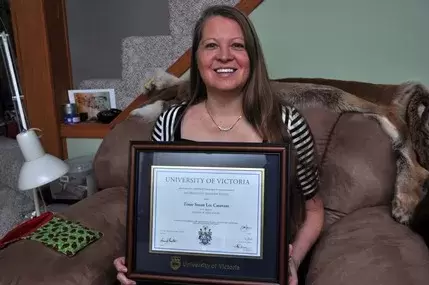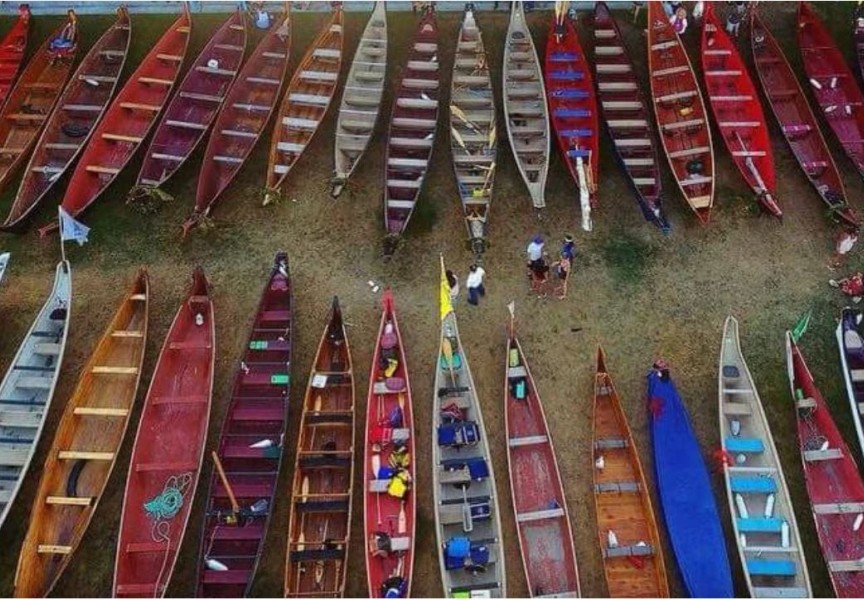With a Master’s degree now tucked under her belt, Tooie Casavant is looking for the opportunity to practice a groundbreaking form of clinical counselling that incorporates traditional First Nations healing practices.
Casavant, a member of Hupacasath First Nation, currently teaches social studies and Grade 9 First Nations culture at Alberni District Secondary School. Last spring, she completed a three-year Master’s of Education degree program at the University of Victoria, specializing in counselling in aboriginal communities.
“It took them 13 years to create the program, and in my understanding, this was the first time it had been offered in Canada,” Casavant said. “The goal of the program is to combine traditional healing with Western clinical modalities.”
Casavant was one of 18 candidates in the first class, drawn from First Nations across Canada, except for two candidates of Celtic descent who had worked with aboriginal people.
“For them, it was a matter of coming to understand they too had ancestors they could call on,” Casavant said.
Just managing the course load was a major challenge while continuing to work full-time.
“Originally, we were only supposed to commute once a month on weekends. I would drive three hours to Victoria on Friday night, do courses Saturday and Sunday and drive back Sunday night. I wouldn’t get a night off for two weeks,” Casavant said. “Then we went to commuting every three weeks, and going full-time in the summer. I couldn’t complain too much. We had one woman who commuted six hours each way from Alert Bay.”
As part of the program, each candidate had to design a practicum, working towards the equivalent of a Master’s thesis, which is typically delivered in written form.
“We didn’t call it a thesis. We called it a project,” Casavant said.
The project was presented orally, much in the same way as a doctoral thesis. Candidates received training in both individual and group counselling.
“My passion was for group. I really like working in a group,” Casavant said. “Out of the group of 18, I was the only one granted an independent practicum.”
The focus was on counseling aboriginal women whose life had been affected by the residential schools, whether directly or “intergenerationally,” as suffered by the descendents of survivors.
“I had to find a clinical counsellor who would act as my supervisor/mentor. I found Dea Haminishi, who practices in town. She’s amazing,” Casavant said.
For her practicum, Casavant had to organize a 13-week group counselling session from scratch.
“I was able to offer it at no charge because I was a student. It was so successful I was able to offer three sessions, with 10 to 12 clients in each group,” Casavant said.
At first she had planned to hold the sessions at the Hupacasath House of Gathering, but shifted the meetings to the guest room she and husband Randy had built over their garage, after a few clients balked at the public venue. Privacy was very much a concern, Casavant said.
“When I opened the group, I let the women know I was a student and that the material I gathered would be used in my project. I would not use their names, but I would use the information,” Casavant said, adding that the women would be given the opportunity to review and delete any information that might compromise their identities or their safety.
The final evaluation process included a two-hour oral exam and a one-hour written exam.
“One of the questions on the oral exam was, ‘How would you start a group in your community?’ And I was flying,” Casavant said. “I had already started a successful group, from the organizing, the recruitment of clients, the advertising, finding a venue, finding supplies...”
As a registered professional member of the Canadian Counselling and Psychotherapy Association, Casavant is now certified to practice on a fee-for-services basis.
“I am not in a position where I am allowed to offer the groups for free,” Casavant said. The next challenge is to find out how to become reimbursed for the work. She is hoping that her prospective clients will be able to find some funding for counselling services.
“I hope to work with women to heal families, to restore the harmony and the balance in the home,” Casavant said.
The blend of clinical and traditional healing has proven effective with First Nations women.
“In the sessions, I was guiding the process, but I was really calling on the spirits for guidance,” Casavant said. “Many of the women asked me, ‘What is this? I’ve been in counselling before and it was never like this.’”
For many First Nations women starting Western clinical counselling, it has often taken two or three sessions just to educate the counsellor about the residential school system and the direct and intergenerational effects it has spawned. In these specialized sessions in Casavant’s guest room, there was no introduction necessary, because each woman in the room, Casavant included, was well versed in how the residential school has affected lives.
While Casavant does not have a specific timeline for establishing a practice, she is determined to make it her life’s work.
“I’m really passionate about counselling and that is the path I’m really on,” she said. I am planting seeds and I’m hoping something will develop







